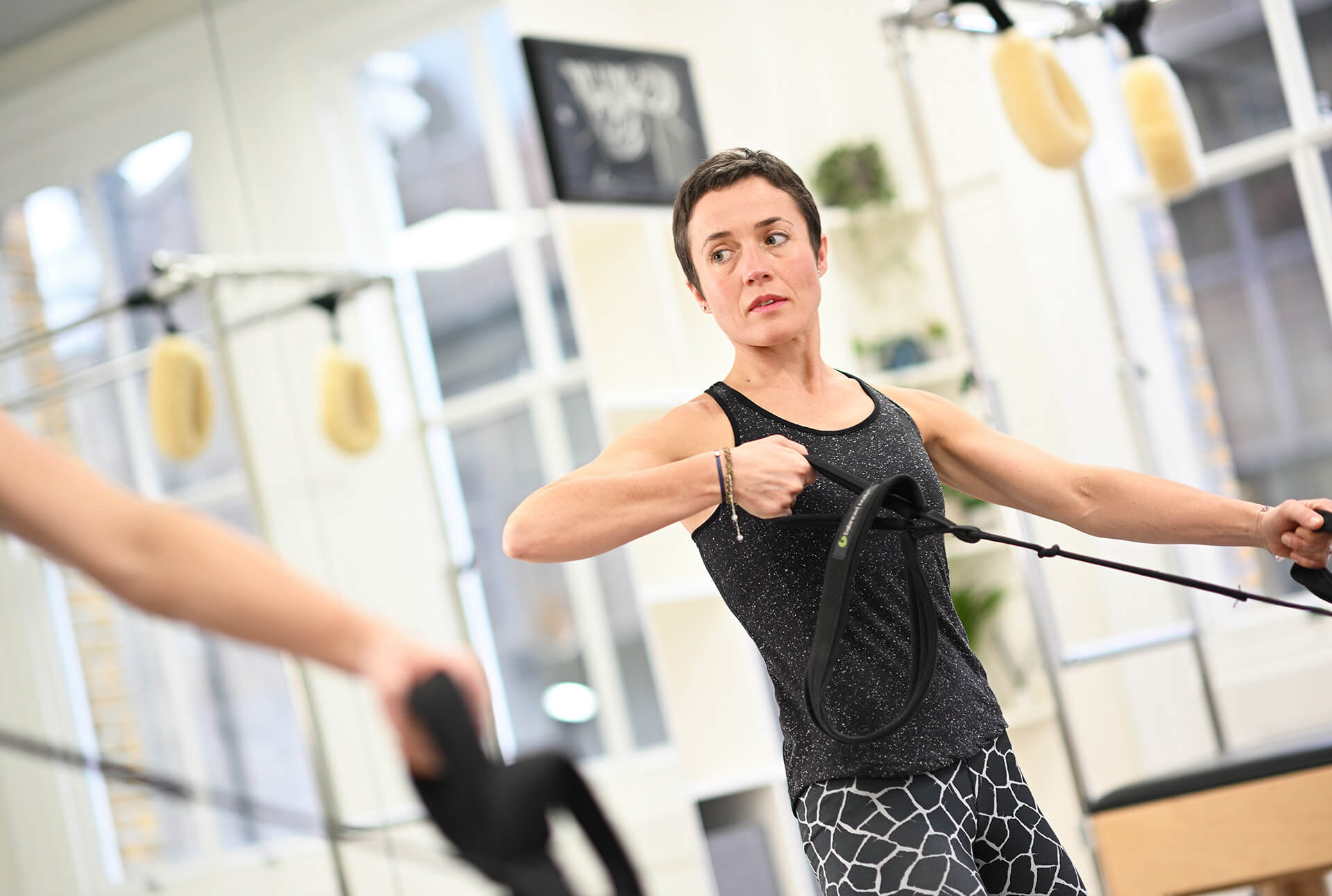Key Contributor: Rocio Herrero Garcia, Clinical Pilates Instructor
Whether you’re a keen road cyclist, a two-wheel commuter or you enjoy a spin with the kids, you’ll know how great cycling can be as a physical activity.
Cycling is an accessible form of exercise for all people that has many health benefits. Because it is low impact, there is less strain on the muscles and joints and is therefore safe for many ages and abilities. It can help improve strength and conditioning of many muscle groups, particularly of the lower limbs and helps improve your aerobic fitness. It is also easily modifiable, meaning that you can change the intensity to suit your goals and needs. Of course, it also has the added benefit of helping you get where you need to go, replacing time sat on the bus or tube.
Have you ever considered Pilates for cyclists to improve your performance? Today’s article explores how Pilates can improve your cycling performance, enhance stability and be useful for general conditioning as well as injury rehab.
We are also giving you our top 5 Pilates and cycling exercises that you can be doing right now at home.
Quick Summary
- Pilates enhances core muscles used in cycling, such as the abdominals, hips, and buttocks, improving balance and stability on the bike. This leads to more efficient and powerful cycling by providing a strong foundation for leg power generation.
- By aligning the legs properly from the hip joint down, Pilates enables cyclists to use their muscle strength more effectively. This even distribution reduces injury risks and enhances overall cycling performance.
- Pilates improves posture, essential for cyclists to avoid injuries to the hips, neck, and upper back. Good posture helps to ensure good bike positioning and Pilates can help improve your postural strength and stamina.
- Cycling is a non-weight-bearing exercise, often leading to lower bone density. Pilates includes weight-bearing and impact exercises that help maintain bone health, reducing fracture risks and improving overall efficiency and power generation in cycling.
How does Pilates help cycling?
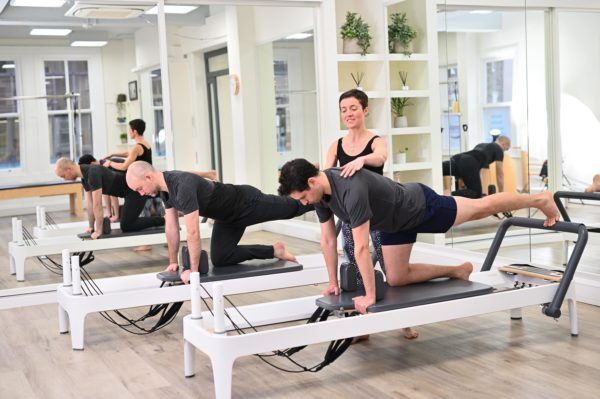
Let’s take a look at the different ways in which Pilates can help!
Core strength
Pilates targets the core muscles, particularly the abdominals, hips and buttocks. Being stronger in your core makes cycling much easier and more efficient.
Strengthening your core, or stability muscles though Pilates also helps you balance on your bike by keeping the spine in a stable position whilst the limbs move. This is beneficial for competitive cyclists in terms of performance enhancement, and for the amateur cycling to work or the shops making it safer and more efficient.
Having a strong and stable foundation will assist you in being able to generate more power through your legs. This in turn will make you faster and more efficient on your bike.
What do our experts say?
‘’
Pilates helps improve awareness of the position of your body on the bike and helps improve the use of your hamstring which can reduce tightness in the shoulders and quads. I also believe that balance is very important, sometimes I think it’s a miracle how anyone can keep on their bike in London! Pilates helps elongate and stretch out all your muscles, helping to keep you more balanced and upright. Rocio Herrero Garcia
Improved limb alignment in cycling
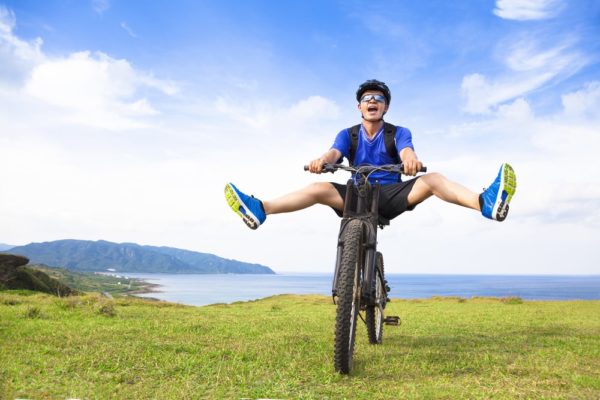
As well as core stability, your performance will also benefit from the improved limb alignment that Pilates offers.
When your legs are well aligned from the hip joint down it will enable you to use the strength in your muscles more effectively making it easier to cycle. This even distribution of your muscle strength will also reduce the risk of injury on your bike.
Pilates is all about moving with ease and that comes with improving the alignment of your limbs for optimal function of your muscles and your body as a whole.
Improve your posture on your bike with Pilates
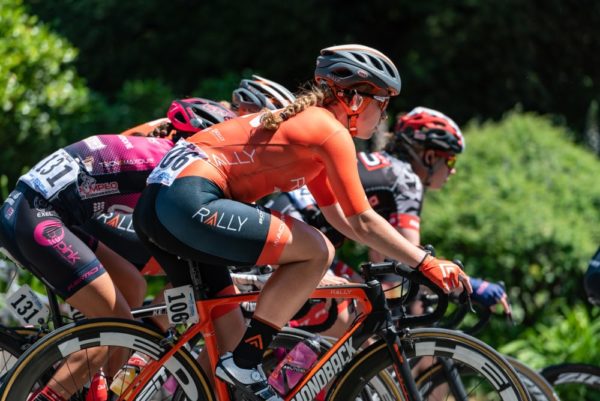
Pilates improves your posture, this is one of the most common things that people think about when we discuss the benefits of Pilates. It doesn’t just apply to when you are sitting at your desk, it is relevant and important in sport too!
Cycling can leave you stooped forward and not in the most optimum position for using your body effectively. This position can also leave your hips, neck, and upper back vulnerable to injury, even more reason to strengthen that core and improve your posture!
The posture required will depend what kind of cycling you are doing and what kind of bike you are on, but it still applies to all. You need to have good strength endurance in the postural muscles to maintain your optimum position throughout the ride.
If you are racing or on a road bike your will be flexed forwards and you need to be able to distribute that flexion evenly through the spine and hips. If you are on more of an upright bike your posture will be different, but you will still need good strength endurance to avoid overloading areas of the spine and risking injury.
Posture is not all about strength but also the length of the muscles. Pilates can help you to work on getting good range of movement through the back of your body to allow you into that perfect racing posture you see in the riders on the tour. It is no good having strength but not the range of movement to get to the required position. Pilates can help with both the length of the muscles and the strength and get the balance right for you.
Bone health for cyclists
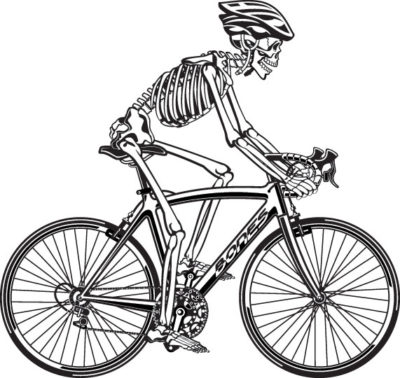
Cyclists frequently have lower bone mineral density because cycling is a non-weight bearing exercise. This leads to an increased risk of fractures caused from crashes or falls. Part of the risk is also associated with lower body weight in competitive cyclists aiming to maximise the power to weight ratio. For our bones to maintain their density we need to be loading them with weight bearing, weighted and impact exercise.
Pilates is not a high impact exercise, but it can get you loading through your spine and hips in a way that cycling doesn’t and this can help with maintaining bone health. This will include exercises in standing and jumping exercises that will load your bones.
Even for the day to day cyclist, those getting to work or getting yourself down to the shops, Pilates can help you increase your efficiency of movement and power generation, making it a much quicker and safer journey (with probably less sweat!).
How can Pilates help me recover from injury?
Prevention is the best cure! Pilates helps you to keep well aligned, distribute the forces and load through your body and avoid those overload injuries.
If you are inured, Pilates can be used as a great way to rehabilitate, particularly physiotherapist-led Pilates. Pilates helps recovery from cycling-related injuries such as lower back pain, hip pain and knee pain. So this form of exercise can be very useful in your daily routine. You can be working on your mobility, and strength in a very safe and progressive way. Pilates can help to get you back from injury, stronger, more flexible, more efficient and cycling better.
Our top five Pilates exercises for cyclists
1. Pilates for cycling– criss cross
This is an excellent classic Pilates exercise, do it slowly and with control to begin with to really engage the muscles in the front and sides of your abdomen.
Lying on your back lift one leg at a time into table-top. Lift the head and chest supporting the head in the hands. Make sure it is the abdominals doing the lifting not the neck muscles tensing to keep the head up.
Reach one leg away and turn your chest towards the opposite knee rotating through your spine. Keep the chest lifted and return to the centre as you bring the leg back in
Repeat on both sides 10 times and try increasing the speed once you have mastered the control.
Top tips – keep your head in the middle of your breast bone – this will encourage you to turn the ribs around the spine rather than just moving the shoulders.
Cradle the head with your thumbs down your neck to get rid of tension here.
Related reading: Benefits of criss cross exercise
2. Pilates for cycling – side lying cycling
This is a great modification of a side lying exercise for cyclists. Get those gluts working along with the abdominals and the upper body.
Propped up on your elbow make sure that you are lifting through your waist and out of your shoulder. Hover the top leg to hip height and do not let it drop down.
Extend the leg back behind you with the toe pointed working the back of the leg and keep the pelvis and spine in neutral. Flex the ankle and then the knee and hip to bring your knee forwards in front of you. Again check that you are keeping the spine still and getting the movement from your hip not your back.
Press the leg away pointing the toe and extending the hip again. Repeat 8-10 times each side.
Top tip – imagine you are pulling your bottom elbow and bottom hip together to keep the connection through your middle and prevent you sagging into the shoulder and hip.
3. Pilates for cycling – superman variation
We have all done superman exercises of one for mor another, but this is a special one for you cyclists! Get mobility and strength through the front and back of your body in this one exercise.
On all fours come into your neutral spine position. Extend one leg back behind you and lift from the hip keeping the spine neutral.
Fold the thigh in underneath you as you allow your spine to curl and press the floor away with your hands. You should feel your abdominals are working to tuck the pelvis which in turn pulls the thigh in.
Roll the pelvis and spine back to neutral as you extend the leg away again.
Lift the breast bone forwards taking the chest through your arms as you lift the leg higher and fold your foot towards your bottom. You should feel the back of your leg and bottom working here and a stretch through the front.
Repeat 8-10 times each side.
Top tip – never lead the movement from your neck, make the pelvis, spine and chest do the work.
4. Pilates for cycling – jump to hop landing
Something to challenge your balance and add a bit of impact! Can you jump and land on one leg?
This might not seem relevant to cycling but we talked about bone health in the blog and this starts to add a little bit of impact for the lower limbs and spine. This is also a great exercise to challenge your balance and lateral control through the hip and oblique abdominals. You need this on a bike, especially when cornering!
Take off on two feet and land on one, can you stick the landing?!
Repeat 20 times each side.
5. Pilates for cycling – swan on the sofa!
The swan exercise in Pilates is done in lots of different ways on all the equipment in the studio but this is the home sofa version!
It will work the back extensor muscles and deep postural muscles in the neck so is a great one for your posture and strength endurance on the bike.
Lying over the sofa position yourself so that you can hold your upper body in line without leaning on your hands. Bend your body forwards taking the crown of your head towards the floor, this flexes your spine. From here use the muscles in your back to lift you back up as you imagine the crown of your head lengthening away from you. Your spine should feel like it is getting longer as you lift.
You can do this with the hands lightly resting on the floor or for more of a challenge bring the hands behind your head.
Frequently Asked Changes
As a cyclist, how often should I do Pilates?
How often you should Pilates always depends on what other exercise you are participating in during the week. If you’re a keen cyclist, it is important to be doing strength and conditioning training away from the bike. If you want to reap the benefits of Pilates for cycling you should aim to participate 1-2 times per week, alongside some other strength-based training such as gym work.
Can I do Pilates to help recover between cycling events?
Pilates is a great way to recover (maybe link to https://complete-pilates.co.uk/how-to-relieve-sore-muscles-after-a-workout/ – not yet optimised but on the list) in between cycling events. Low-impact exercise like Pilates that can have a focus on mobility, can help reduce the effects of muscle soreness and help improve flexibility and range of motion of stiff joints. Because Pilates is a mindful form of exercise, it can also help reduce the mental stress of competition or performance and help recentre yourself for the next event. Furthermore, while your body recovers, it is a perfect time to work on posture and core strength and stability.
When should I do Pilates?
You can do Pilates any time! Pilates is such a varied form of exercise and can be modified to suit any goal or ability. Because of this, Pilates can really be done at any time. If you are using Pilates to prepare your body for an event or goal, you may choose to do it as a precursor to your more strenuous training as it can help improve your range of motion and body alignment and help wake up your deep stabilisers which will help you during more intense movement. Or, you may use Pilates to help recover after exercise, to help reduce the effects of muscle soreness and joint stiffness. For some, Pilates is their main form of whole body exercise, in which case it can be done every day!
Pilates vs Cycling (this is something that users are searching for with regards to choosing between spin class and Pilates – perhaps we say it’s never a case of either or and it depends on your goals?
If you’re wondering whether Pilates or a spin class is best, the answer is both! If you need to choose one, it really depends on what your goals are. A spin class will provide more of an aerobic workout, getting your heart rate up and your lungs and legs going! Pilates on the other hand, is a low-impact form of exercise that will include training for strength, endurance, coordination, balance and mobility. All of these things should be included into your week so where possible, you should really do both!
Visit Complete Pilates
You can find us at one of our Pilates studios in London and speak to us about Cycling conditioning. You can find us at Complete Pilates in Angel or any of our studios (see our Chelsea Pilates studio or our Pilates studio in London City) for more information, please get in touch online or contact us on 0203 764 5668.
Let us know how you get on with the exercises in the comments below!
If you are not sure if these exercises are right for you why not book a session with one of our instructors. We are seeing clients both in person in the studio and online.
Come and see how you could improve your cycling with Pilates!
Education is key:
These blogs are designed to give information to everyone, however, it is important to remember that everyone is different! If you have not seen one of our therapists and have any questions about injuries, what you have read or whether this may be useful to you, please just ask. We are more than happy to help anyone and point you in the right direction. Our biggest belief is that education is key. The more you understand about your injury, illness and movement, the more you are likely to improve.




